Judi Lynn
Judi Lynn's JournalMinistry of Education to Investigate University Course Called '2016's Coup'
02/23/2018 - 11H22
Ouvir o texto
GÉSSICA BRANDINO
ISABEL FLECK
FROM SÃO PAULO
CAROLINA LINHARES
FROM BELO HORIZONTE
A subject called "the coup of 2016 and the future of democracy in Brazil", offered by the undergraduate political science course of UnB (University of Brasilia), triggered off a reaction from the Ministry of Education, which requested, on Thursday (22), an "administrative misconduct" investigation related to the course's creators.
The course is scheduled to start on March 5, taught by professor Luis Felipe Miguel, full professor of the Political Science Institute, and one of its goals is "to understand the fragility elements of the Brazilian political system which allowed the democratic rupture in May and August 2016, resulting in the ousting of President Dilma Rousseff [PT] ".
The subject also intends to analyze "the agenda of setbacks regarding rights and restrictions on freedom" under Michel Temer's (MDB) administration.
The Ministry had previously issued a note accusing the course creators of "political and ideological proselytism by means of a public institution".
More:
http://www1.folha.uol.com.br/internacional/en/brazil/2018/02/1957852-ministry-of-education-to-investigate-university-course-called-2016s-coup.shtml
2 lions from Mideast war zones reach South African refuge
Christopher Torchia, Associated Press Updated 1:46 pm, Monday, February 26, 2018

IMAGE 1 OF 15 A 4-year-old lion named Simba, who was rescued from Syria by the animal rights group Four Paws, is released into an enclosure at the Lionsrock Lodge and Big Cat Sanctuary in Bethlehem, South Africa? in Bethlehem, South Africa, Monday, Feb. 26, 2018. Two lions rescued from neglected zoos in war zones in Iraq and Syria were transported to South Africa on Monday to live at a sanctuary with other animals that survived harsh conditions in captivity elsewhere in the world.
LIONSROCK BIG CAT SANCTUARY, South Africa (AP) — Two lions rescued from neglected zoos in war zones in Iraq and Syria arrived in South Africa on Monday to live at a sanctuary with other animals that survived harsh conditions in captivity elsewhere in the world.
The male lions were transported in metal crates on a Qatar Airways flight after leaving an animal refuge in Jordan on Sunday. They were loaded onto vehicles for a drive of several hours to their new home at the Lionsrock facility near the town of Bethlehem. The lions emerged into separate grassy enclosures, and other lions behind nearby fences let out deep-throated growls and moans.
"They are already saying, 'Hello,'" said Hildegard Pirker, head of the animal welfare department at Lionsrock. As one of the new arrivals bounded around his new home, Pirker said: "You're in Africa, finally."
Born in captivity, the lions had never been on the continent. They were emaciated and dehydrated after the international animal welfare group Four Paws extracted them from a zoo in eastern Mosul in Iraq and an amusement park near Aleppo in Syria. The two cities have experienced some of the worst fighting that has hit both countries in recent years, killing large numbers of people and leaving neighborhoods in ruins.
More:
https://www.chron.com/news/crime/article/2-lions-from-Mideast-war-zones-head-to-South-12708393.php
As Monuments to White Supremacists Fall, a New Statue Celebrating Chilean Human Rights Hero Arises
Remarks at the unveiling of the Orlando Letelier statue
February 26, 2018 | Sarah Anderson
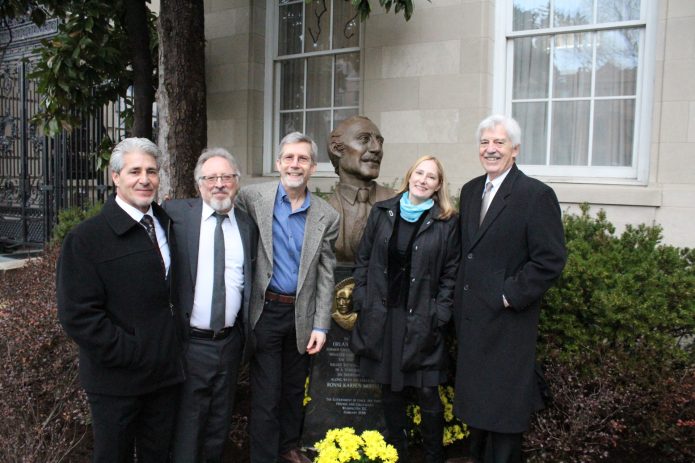
(From left) Orlando Letelier’s son Francisco, Peter Kornbluh of the National Security Archives, IPS
Director John Cavanagh, IPS project director Sarah Anderson, and journalist John Dinges.
More than 100 years ago, when groups began installing statues across this country of pro-slavery Civil War leaders, they were hoping to embolden white supremacists for years to come.
Thirty-six years ago, when Peter Kornbluh and others helped install the monument to Orlando Letelier and Ronni Karpen Moffitt on the other side of Sheridan Circle, they were hoping to embolden human rights heroes for years to come.
Today we celebrate another monument designed to embolden human rights heroes. And we can finally say we not only have a tribute to Orlando and Ronni on the soil of a country (the United States) that supported the Chilean dictatorship that ordered their killing. We now also have one on property that belonged to that dictatorship.
And we are marking this milestone at a time when the monuments to white supremacists are finally starting to come down.
More:
http://www.ips-dc.org/monuments-white-supremacists-fall-new-statue-celebrating-chilean-human-rights-hero-arises/


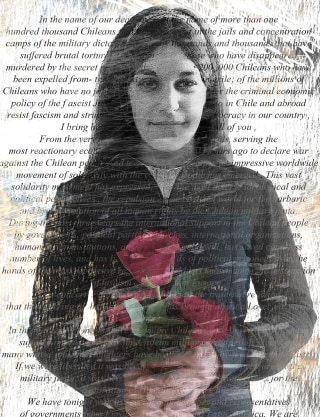
Ronni Moffit


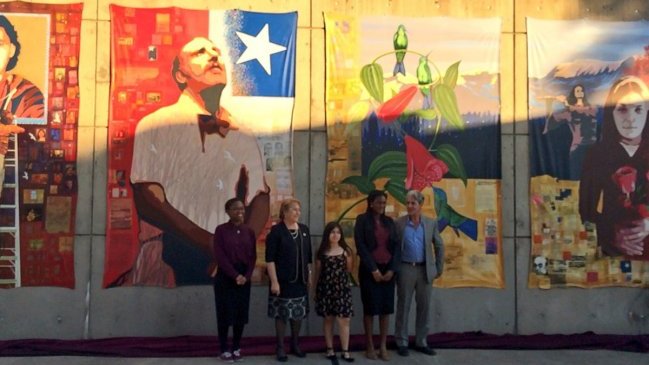
Mural painted by the son of Orlando Letelier showing his father and his father's aide, Ronni Moffit




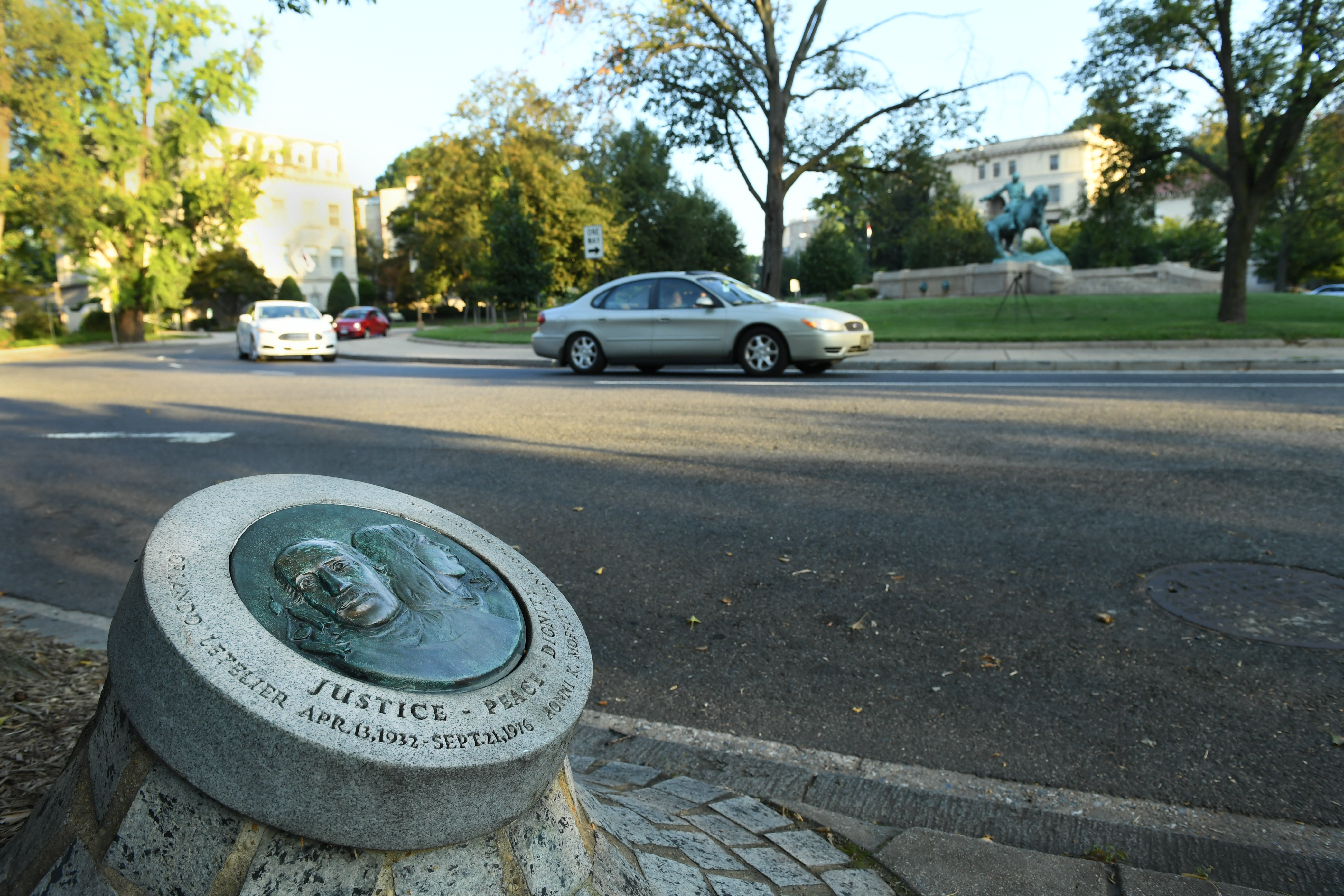
First Person: Returning to Cuba more than a half-century later I just went back for the first time s
I just went back for the first time since my family left in 1959
DAVE RIVERA
FEB 23, 2018 11:00 PM
I lived in Cuba from the age of 1 to 14 — my father was in the U.S. military and my mother was Cuban — and I returned last month to Cuba for the first time since our family left in 1959. I didn’t know what to expect, mainly because of the economic sanctions that have been imposed on the country by the United States for nearly 60 years. From some of the images we have seen from afar, we expected to see a lot of old cars, bicycles, general shortages of almost everything else and a broken people.
We landed at Jose Marti airport, went through customs and exited to a waiting fleet of modern European cabs. Our cab ride to the bed and breakfast where we stayed took us on a modern four-lane highway to the crowded one-way streets of Old Havana.
Early on, the U.S. trade embargo deeply affected Cuba. More recently, though, the rest of the world has resumed trade relations with Cuba, and the main effect of the U.S. embargo has been keeping American investment and tourism down to a trickle. While we were there, we saw ample evidence of Europeans, Asians and South Americans.
Old Havana streets are bustling with tourists and tourism-related activities. Drivers with their antique cars gather around plazas near hotels waiting for fares. Street vendors populate corners, and roaming groups of street performers were everywhere we went in the center city. Markets, sidewalk cafes and stores were busy; some even had waiting lines.
More:
http://www.post-gazette.com/opinion/Op-Ed/2018/02/24/First-Person-Returning-to-Cuba-more-than-a-half-century-later/stories/201802240022
White Settlers Buried the Truth About the Midwests Mysterious Mound Cities
Pioneers and early archaeologists credited distant civilizations, not Native Americans, with building these sophisticated complexes

View of Monks Mound from Woodhenge Circle (Photo courtesy of Sarah E. Baires)
By Sarah E. Baires, Zócalo Public Square
smithsonian.com
February 23, 2018 10:56AM
Around 1100 or 1200 A.D., the largest city north of Mexico was Cahokia, sitting in what is now southern Illinois, across the Mississippi River from St. Louis. Built around 1050 A.D. and occupied through 1400 A.D., Cahokia had a peak population of between 25,000 and 50,000 people. Now a UNESCO World Heritage Site, Cahokia was composed of three boroughs (Cahokia, East St. Louis, and St. Louis) connected to each other via waterways and walking trails that extended across the Mississippi River floodplain for some 20 square km. Its population consisted of agriculturalists who grew large amounts of maize, and craft specialists who made beautiful pots, shell jewelry, arrow-points, and flint clay figurines.
The city of Cahokia is one of many large earthen mound complexes that dot the landscapes of the Ohio and Mississippi River Valleys and across the Southeast. Despite the preponderance of archaeological evidence that these mound complexes were the work of sophisticated Native American civilizations, this rich history was obscured by the Myth of the Mound Builders, a narrative that arose ostensibly to explain the existence of the mounds. Examining both the history of Cahokia and the historic myths that were created to explain it reveals the troubling role that early archaeologists played in diminishing, or even eradicating, the achievements of pre-Columbian civilizations on the North American continent, just as the U.S. government was expanding westward by taking control of Native American lands.
Today it’s difficult to grasp the size and complexity of Cahokia, composed of about 190 mounds in platform, ridge-top, and circular shapes aligned to a planned city grid oriented five degrees east of north. This alignment, according to Tim Pauketat, professor of anthropology at the University of Illinois, is tied to the summer solstice sunrise and the southern maximum moonrise, orientating Cahokia to the movement of both the sun and the moon. Neighborhood houses, causeways, plazas, and mounds were intentionally aligned to this city grid. Imagine yourself walking out from Cahokia’s downtown; on your journey you would encounter neighborhoods of rectangular, semi-subterranean houses, central hearth fires, storage pits, and smaller community plazas interspersed with ritual and public buildings. We know Cahokia’s population was diverse, with people moving to this city from across the midcontinent, likely speaking different dialects and bringing with them some of their old ways of life.

View of Cahokia from Rattlesnake Mound ca 1175 A.D., drawn by Glen Baker
(Image courtesy of Sarah E. Baires)
The largest mound at Cahokia was Monks Mound, a four-terraced platform mound about 100 feet high that served as the city’s central point. Atop its summit sat one of the largest rectangular buildings ever constructed at Cahokia; it likely served as a ritual space.
Read more: https://www.smithsonianmag.com/history/white-settlers-buried-truth-about-midwests-mysterious-mound-cities-180968246/#gMJWq2s4GDbYjTOL.99
Democratic Congress Members Called for Better Cuba-U.S. Relations

Havana, Feb 22 (Prensa Latina) U.S. Democratic Congress members who visited Cuba this week defended the approach both countries started late 2014 to advance to the normalization of relations.
The bipartisan delegation was formed by senators Patrick Leahy (Vermont), Ron Wyden (Oregon) and Gary Peters (Michigan) and representatives Jim McGovern (Massachusetts), Kathy Castor (Florida) and Susan Davis (California), who talked in this capital with authorities, including President Raul Castro, small businesspeople and other sectors of society.
In Cuba, legislators criticized the policy followed by president Donald Trump to the island, characterized since his arrival to the White House -in January, 2017- intent on intensifying the economic, commercial and financial blockade enacted over half a century ago and retreat from the progress achieved in 2015 and 2016.
Presidents Barack Obama and Raul Castro announced in December, 2014, a process of approach aimed at normalizing relations between Havana and Washington, which led to holding high-level meetings in both capitals and the signing of some twenty cooperation agreements.
More:
http://www.plenglish.com/index.php?o=rn&id=24860&SEO=democratic-congress-members-called-for-better-cuba-u.s.-relations
Are Colombias social leaders facing another extermination?
by Stephen Gill February 22, 2018
More than 200 social leaders, peasant representatives and human rights defenders have been murdered since the start of Colombia’s peace process, according to a report.
The killings are spurring fears that the widespread killing could be a repetition of an extermination campaign in the 1980s and 1990s in which thousands of leftists were murdered, and spurred a wave of retaliatory guerrilla violence.
. . .
The ongoing mass killing of leaders begins to resemble a political extermination campaign carried out by paramilitary groups and state forces after a peace deal with the FARC in 1985.
More than 3,000 members of the leftist political party Patriotic Union, including presidential candidates, were assassinated in the decade after that agreement.
The political extermination of the leftists spurred the most violent and traumatic period in the 50-year history of Colombia’s armed conflict.
Since 1964, the year groups like the FARC and ELN were founded, more than 265,000 Colombians have been killed. Millions were displaced.
. . .
https://colombiareports.com/more-than-200-social-leaders-assassinated-during-colombia-peace-process-report/
Why Colombias former president is accused of forming bloodthirsty death squads
by Adriaan Alsema February 22, 2018

Evidence and multiple witness testimonies indicate that Colombia’s former president, Alvaro Uribe, helped form a death squad. The big mystery is why this was never properly investigated.
The Bloque Metro, the group allegedly formed by the Uribe family and their neighbors, is hardly known abroad. The death squad’s rejection of drug trafficking kept it out of sight of US prosecutors.
In Antioquia, however, many remember the far right death squad that left at least 4,000 victims in Uribe’s home province.
The Bloque Metro was not investigated by a court until 2016, because the group was excluded from the so-called “Justice and Peace” process that sought to clarify paramilitary crimes.
More:
https://colombiareports.com/colombias-former-president-accused-forming-bloodthirsty-death-squads/
Dont butt in! Young birds taught the art of conversation
The acquisition of singing rules in canebrake wrens shows a similar pattern to human conversation learning.
Press Association
Last updated:21 February 2018 - 12.10am
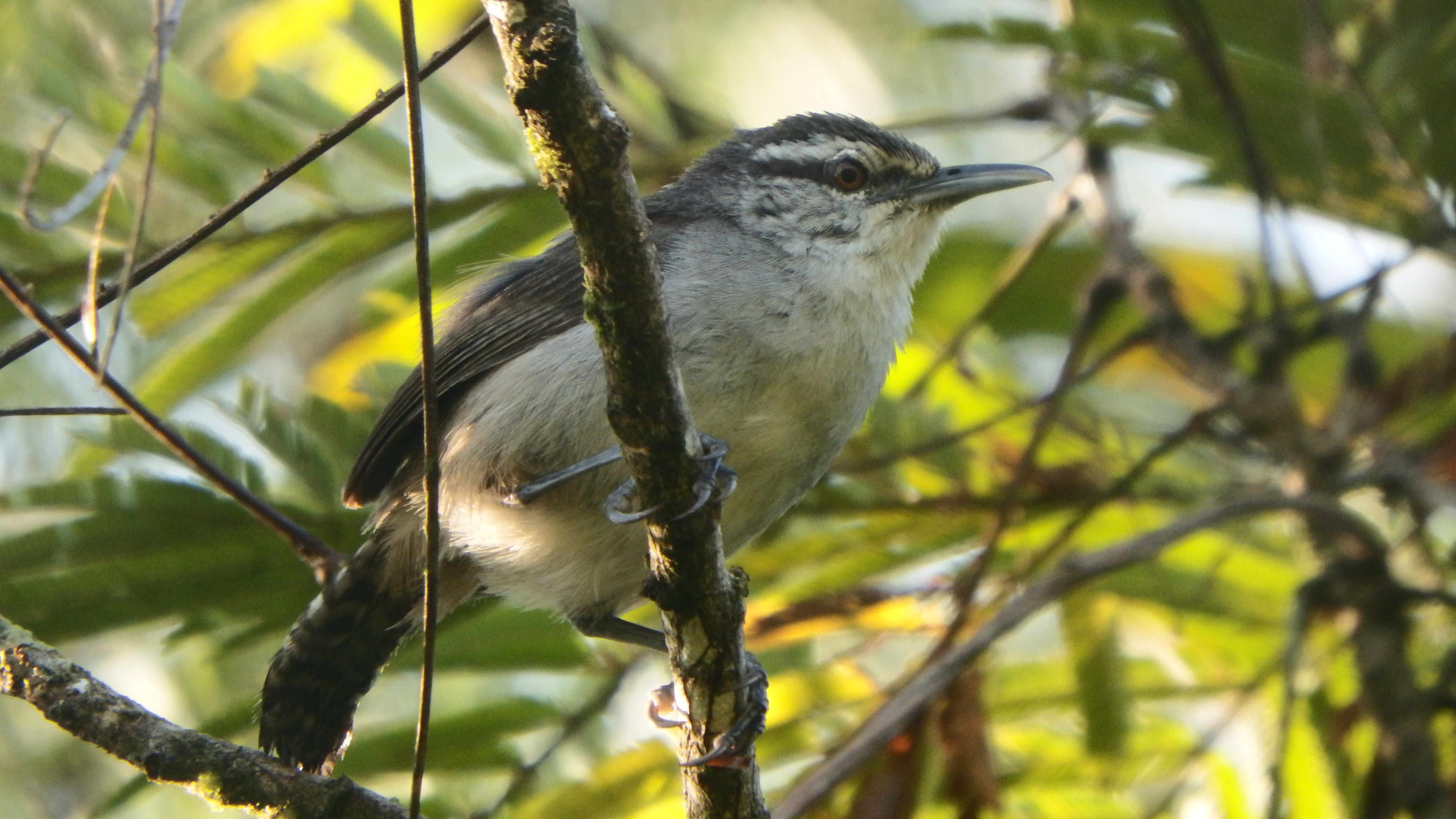
A tropical songbird learns how to conduct polite “conversations” from its parents, research has shown.
As every well brought up child knows, it is rude to interrupt. The same lesson appears to be taught to young canebrake wrens, which become better able to avoid singing over their parents as they get older.
Like many other songbirds, adult canebrake wren pairs engage in “duets” in which each partner takes turns to chirp a precisely timed phrase.
Scientists have shown that to-and-fro song duets performed by mated birds mirror human conversations.
More:
http://home.bt.com/news/science-news/dont-butt-in-young-birds-taught-the-art-of-conversation-11364253154708
US Foreign Policy is the Greatest Crime Since WWII, former US Attorney General Ramsey Clark
by Jay Janson / February 20th, 2018
Last week, the present US Secretary of State, Rex Tillerson, during his trip to five Latin American nations, made headlines world wide when he made the following barely veiled threatening statement: “In the history of Venezuela and South American countries, it is often times that the military is the agent of change when things are so bad, and the leadership can no longer serve the people.” and shortly afterward referring to the elected president of Venezuela, Nicolas Maduro, added: “If the kitchen gets a little to hot for him, I am sure that he’s got some friends over in Cuba that could give him a nice hacienda on the beach and he could have a nice life over there.” US secretaries of state have a lot of balls, as Tillerson’s gangster tough guy remarks showed.
There are few countries in Latin America that have not experienced the USA both secretly and overtly backing a right wing military government coup. The US Secretary of State’s criminally insane backhanded remarks favoring a civil war, with all the probable loss of lives a civil war would bring, seems to fit as appropriate within a US foreign policy of world domination. Human suffering has never been of any consequence to the financial interests of that 1/10 of 1 per cent of Americans who, to one degree or another, rule us all.
That is the way it has been since the end of the Second World War, a war made possible by the American investments and joint venturing in the rearming of a prostate Nazi Germany1, a war that made the USA rich and the first all powerful single superpower.
Now that China is about to replace the USA as the most powerful economy in the world2, maybe the days of such arrogance from a US Secretary of State are numbered, though the all powerful criminal media owned by the US military industrial complex would have us think otherwise. The CIA overseen mainstream media is preparing its audience for a probable future ‘necessary’ war with US designated ‘adversaries’ Russia and China.
More:
https://dissidentvoice.org/2018/02/us-foreign-policy-is-the-greatest-crime-since-wwii-former-us-attorney-general-ramsey-clark/
Profile Information
Member since: 2002Number of posts: 160,527